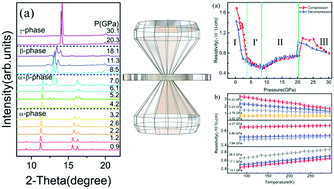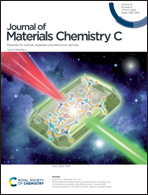Structural phase transition of BiSb and formation of Weyl semimetallic phase under pressure: calculations and experiments†
Abstract
Being a well-known thermoelectric material and a first-generation topological insulator at ambient conditions, bismuth antimonide (BiSb) is predicted to transform into a Weyl semimetallic phase under pressure, whose structures has remained unsolved for decades. Herein, we have solved the high-pressure phase transitions of BiSb using angle-dispersive X-ray diffraction combined with first-principles structural search. Two structural phase transitions are found at 8.5 and 20.3 GPa. The two-step evolution process in the first phase transition is explained. Electrical transport measurement reveals that the pressure-induced carrier concentration increased drastically and metallization occurred at ∼4 GPa. There are slight abnormal changes in electrical parameters at ∼8 and 20 GPa. Combined with structural characterizations, in situ resistivity and Hall-effect measurements, and theoretical calculations using density functional theory, it is revealed that the first anomaly is caused by the formation of the Weyl semimetallic state, which is attributed to a Bi–Sb bond between layers. The subsequent two are attributed to the trigonal to tetragonal and tetragonal to cubic phase transitions. Our research provides a route to find manipulable topological Weyl semimetallic transport properties in materials with broken space-inversion symmetry and helps to explore the phase transition of similar non-metallic alloys under high pressure.



 Please wait while we load your content...
Please wait while we load your content...